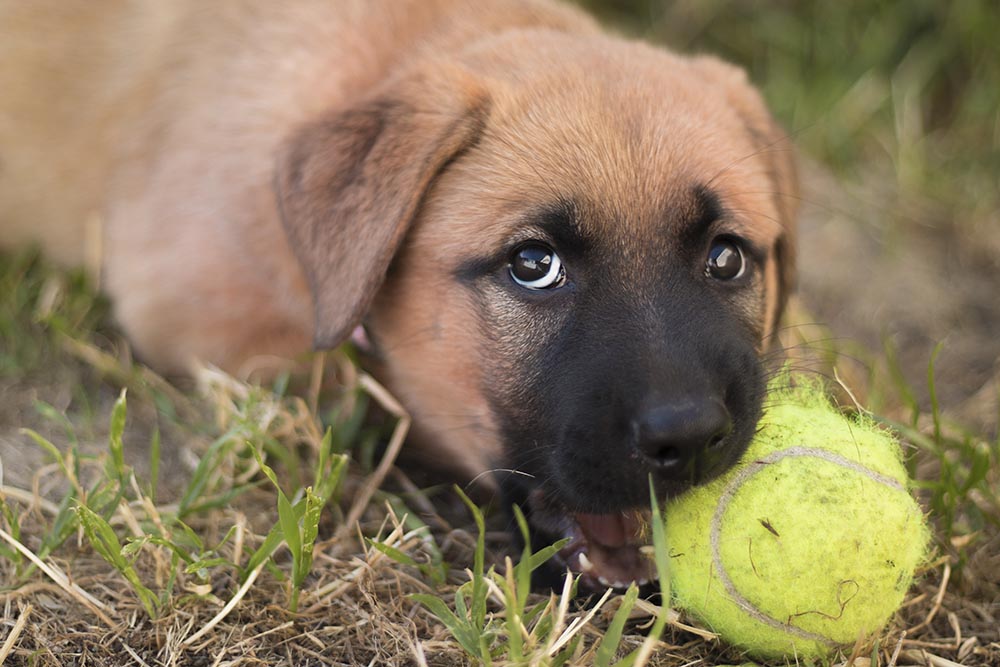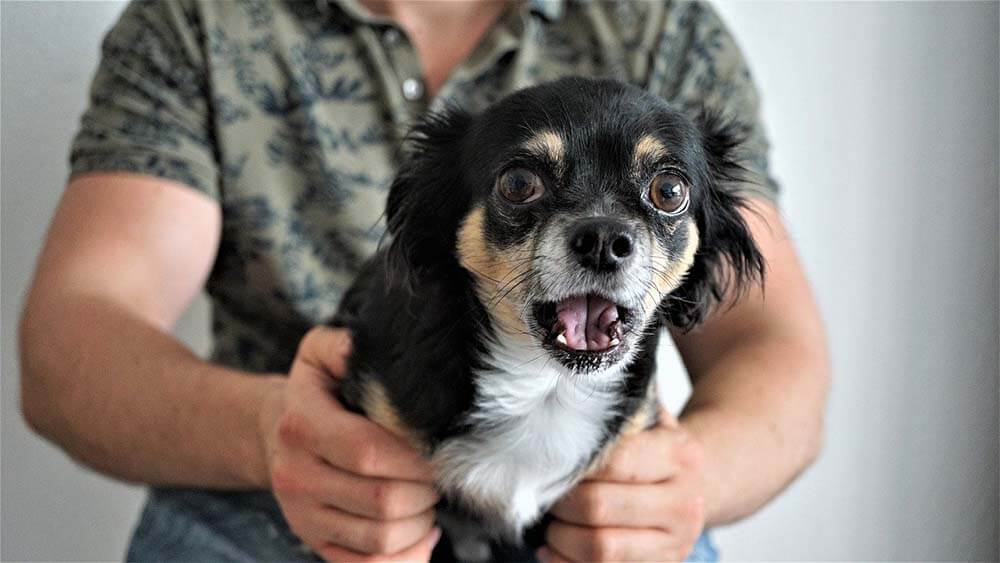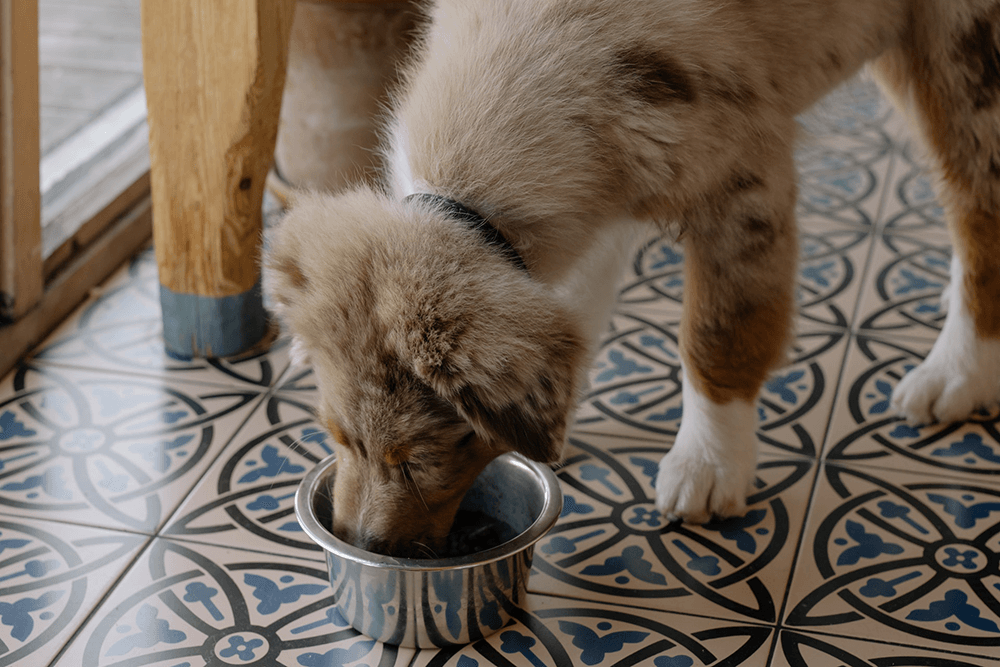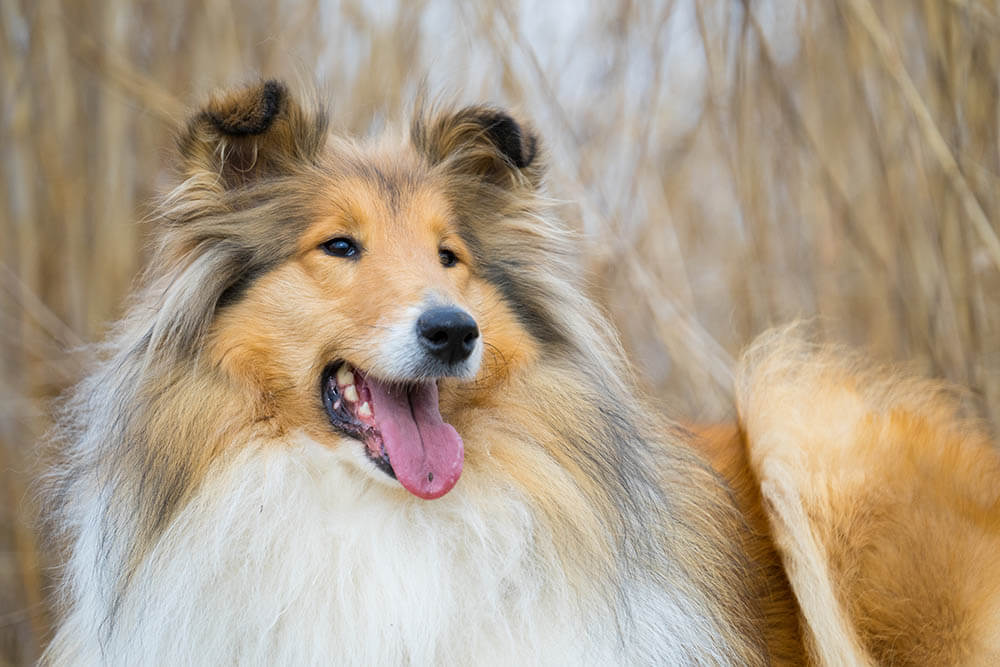Only cats get hairballs, right?
Nope! Dogs cough up hairballs, too. As do cows, rabbits, and other furry or hairy creatures.
But what, exactly, are hairballs? Why do dogs get hairballs? And what can you do to prevent them?
Read on as we discuss hairballs in dogs!

What are hairballs?
The technical name for hairballs is trichobezoar, which itself is a type of bezoar – a fancy name for a hard, undigested mass of material, such as hair, stones, seeds, or plant fiber that accumulates and congeals in the digestive tract.
Canine hairballs are formed when a dog ingests loose hair or fur, which, over time, gathers to form a concentrated mass in the digestive system. Hairballs don’t always consist of loose hair only, however; sometimes, the hair gets entangled with other indigestible elements to form the hardened clump.
Normally, a dog’s digestive tract passes swallowed strands of hair through the gut without any problems. Unfortunately, hairballs tend to behave like a snowball; once the formation of a hairball begins, other accidentally ingested hairs get ensnared by the mass. The mass then swells in size until it can no longer be removed from the dog’s digestive system the natural way. And the larger the trapped hairball gets, the greater the threat it poses to your dog’s health.
As hairballs can cause dogs discomfort, the canine body may get rid of the hairball through vomiting. If a dog coughs or retches constantly, they may be trying to eject a hairball via the throat and mouth.
While dog hairballs are rare, some dogs are more prone to developing them than others. Long-haired dog breeds, for example, have hair that’s more likely to get entangled in the tummy. Heavy shedders are also at an increased risk of getting hairballs.
Despite their name, hairballs are typically cylindrical.

Common causes of hairballs in dogs
The canine body usually expels swallowed hair as part of fecal matter. But sometimes, these hairs get stuck in the digestive system, instead.
Below are the various ways hairs find their way into your dog’s stomach to form a hairball.
Grooming
Dogs lick themselves clean – it’s part of their regular self-grooming routine. In the process, they inadvertently swallow not only their own hair but also any materials sticking to their coat, including dirt, carpet fibers, etc.
In addition to self-grooming, dogs also clean other pack members. If you have more than one furry friend at home, then your dogs have likely ingested the stray hairs of their fellow pets.
Mental health and behavioral issues
Mental health issues such as anxiety, stress, and depression encourage extreme repetitions of otherwise normal behaviors such as licking.
The simple act of licking releases pleasurable hormones in the dog’s body. An anxious dog may therefore lick themselves excessively to relieve feelings of stress or anxiety. This, unfortunately, results in hair loss. And where does all that loose hair go? You guessed it – the stomach. And the more hair your dog licks off and swallows, the greater the amount of accumulated hair in their belly.
Even boredom can provoke strange and/or destructive behaviors – including the excessive licking of the self or other surfaces. A bored dog may even swallow hair on purpose to entertain themselves.
Physical health issues
Medical conditions can cause dogs great distress. Physical discomfort compels repetitive behavior.
For instance, a dog licking their elbow excessively may be experiencing joint pain. Or they may have extremely itchy skin due to a skin irritation caused by an allergic reaction, a tick or flea infestation, or fungal or bacterial infection.
Obsessive licking, excessive hair loss, and hairballs can therefore be symptoms of an undiagnosed health problem. This is why every dog owner should consult a vet the moment they observe such strange behaviors in their pet.
Pica
If a dog ingests their own fur or hair on purpose, they may have an eating disorder known as pica, which “involves eating items that are not typically thought of as food and that do not contain significant nutritional value, such as hair, dirt, and paint chips.”
For this reason, pica can also make dogs chew on rugs, plush toys, or other objects whose fibers, when swallowed, can form a hardened lump in the stomach.
Pica is caused by various issues, including nutritional deficiencies, hormonal imbalances, parasitic infections, and anxiety or stress.

Predation
A dog’s natural prey drive can push it to hunt down small animals for food. Eating prey such as rodents can cause the fur of these other animals to accumulate in a dog’s gut.
Thankfully, while the prey drive is present in most dogs, it’s not always strong enough to encourage the killing of other animals. Many dogs express their predatory instinct through play.
Poor nutrition
Poor nutrition can harm your dog’s coat, leading to loose fur or hair.
If your dog is experiencing severe hair loss, even the gentlest lick can cause their hair to fall out. Consequently, more hair is likely to get swallowed.
Nursing behaviors
If a mother dog has lots of hair around their nipples, any suckling puppies may end up ingesting that hair. A pet parent should therefore shave the mother’s belly before allowing the puppies to nurse.

Hairballs in dogs: symptoms and health risks
Unless hairballs are expelled through vomiting, it’s quite difficult to tell if there are any in your dog’s gut. Nevertheless, hairballs in dogs usually manifest as symptoms many pet parents can observe.
Coughing and gagging
Coughing is the body’s attempt to clear its airways. Gagging is a reflex caused by the stomach’s efforts to expel an obstruction from the digestive tract.
If you see a dog gagging and coughing, their body may be trying to eject something from their stomach. This may be a hairball that’s causing a stomach blockage or anything else they can’t digest.
If the coughing and gagging cease after the hairball is successfully ejected, you most probably have nothing to worry about.
But if your dog gags or coughs nonstop, they may have additional hairballs that they can’t expel. Alternatively, they may have a medical condition, disease, or illness. In the case of the latter, you’ll likely observe other symptoms such as excessive drooling or panting, nasal discharge, breathing difficulties, lethargy, or fever. Problems such as heart disease, distemper, sinusitis, kennel cough, and tracheal collapse can all cause excessive coughing and gagging.
In some cases, hairballs co-occur with health problems.
If your dog won’t stop coughing and gagging whether or not they have hairballs, you should bring them to the vet. Issues such as kennel cough make your dog miserable, while untreated respiratory disease can be fatal. As for unremoved hairballs, they can cause serious, even life-threatening harm.

Poor appetite
The abdominal discomfort and nausea brought about by hairballs can cause a dog so much distress that they lose their appetite.
A dog with poor appetite may refuse meals and even treats. They may eat only a tiny portion of their meal before leaving it unfinished. They may also exhibit a lack of energy.
Keep in mind that a poor appetite is a general symptom of discomfort; it isn’t exclusive to digestive problems or hairballs.
Take the prolonged rejection of food seriously. If your dog hasn’t eaten in 48 hours, seek a veterinarian’s help as soon as you can.
Diarrhea and constipation
Constipation and diarrhea are signs that the dog’s body is trying, but failing, to expel a stomach obstruction such as a large, hardened hairball. And the larger and more solid the hairball, the tougher it is to vomit out of the stomach or excrete along with fecal matter.
A dog with diarrhea may pass streams of watery stools or extremely soft stools several times a day. The amount passed can range from small to overwhelming.
A constipated dog may squat or strain to poop but either fail to pass stool or only pass a tiny amount of (sometimes watery) stool. They may also drag their rear along the ground.

Treating hairballs in dogs
If hairballs aren’t expelled from the dog’s body, they can obstruct the gastrointestinal tract. Blockages can, in turn, cause internal damage that can seriously harm your dog. Thankfully, there are various ways to solve the problem of hairballs in dogs.
Veterinary care
The best solution to dog hairballs is treatment by a veterinarian.
In most cases, hairballs are excised via surgery. This requires hospitalization for a few days and an extended recovery period.
Hairball removal can also be accomplished using an endoscope, which is inserted into the stomach via the dog’s throat.
Whatever the technique used, a skilled vet will remove existing hairballs as well as excess hair follicles before they can clump together. Post-treatment care, medication, and a special diet will further restore your dog to health.
The prognosis is good for dogs whose hairballs are removed as early as possible. If hairball-induced blockages damage the stomach, your dog can grow dangerously ill unless additional treatment is provided.
Home remedies
Hairballs can also be treated at home as long as they aren’t causing significant distress or prolonged symptoms that threaten your dog’s health.
You can feed your dog plain canned pumpkin, whose rich fiber content helps break down the hairballs so that they’re easier to pass. Make sure not to add any ingredients or seasonings to the pumpkin, as these can harm your dog.
You can mix olive oil or fish oil into your dog’s food. This lubricates the hairball and the gut so that the hairball moves through the gastrointestinal tract more easily.
Giving a dog with hairballs lots of drinking water also helps. Water prevents the gut from drying up so that hairballs don’t grow worse and blockages are less likely to develop. Water also prevents constipation, allowing the dog to pass stool and hairballs more easily.
Laxatives also help treat hairballs by softening your dog’s stool so that it passes more easily through the gut. Take note, however, that laxatives can only treat partial obstructions. They also cause uncomfortable cramping and diarrhea. Seek veterinary advice before giving your dog laxatives.
If these remedies don’t work, your dog’s hairball may be too large to pass naturally. Worse, they may have caused a complete obstruction in the gut. In either case, quick veterinary intervention is necessary.

Preventing hairballs in dogs
Because the best cure is prevention, the best way to treat hairballs is to prevent them from developing in the first place.
There are several ways to prevent hairballs, including:
Regular trips to the vet
As previously mentioned, health issues can provoke unhealthy extremes of normal behaviors such as licking, which help develop hairballs.
Thankfully, a vet can prevent the occurrence of health problems and treat existing problems before they grow worse. Parasitic infestations, allergic reactions, skin conditions, and other concerns that can cause excessive licking can all be prevented and treated by a vet.
A vet can improve your dog’s diet, which can strengthen their coat and prevent excessive hair loss. A healthy diet can also prevent issues such as pica, anemia, and others.
A vet can even prescribe anti-anxiety medication to help your dog with their mental health problems.
For these reasons, you should take your dog to the vet for a thorough medical examination at least once a year.
Help from an animal behaviorist or dog trainer
If a medical condition isn’t behind your dog’s poor mental health, an animal behaviorist or dog trainer can determine the underlying cause of their issue. They’ll then use training techniques to heal your dog’s mind and prevent the reoccurrence of problematic behaviors.
Training itself has many benefits, including boosting your dog’s confidence so they’re less likely to engage in excessive grooming and other behaviors conducive to hairball formation.
Physical and mental stimulation
If your dog rarely has anything interesting to do, they’ll grow not only bored but also mentally and physically unwell. The result? Behaviors that can develop hairballs.
To prevent hairballs and other issues, give your dog lots of exercise and fun activities. Daily walks are a must, as are occasional trips to pet-friendly locations where they can interact with other animals and have exciting new experiences. Puzzle toys and games nourish the mind. Training also does wonders for a dog’s physical and mental wellbeing.
Regular grooming
You should have your dog groomed by a professional at least once a month to prevent hairballs.
A groomer will brush your dog’s coat, removing stray hairs that can otherwise be inadvertently ingested. Trimming said coat removes matted hairs to make brushing easier.
Of course, you can do the brushing yourself at home – just be prepared for a mess! Use appropriate grooming tools, and make sure to learn how to properly trim dog hair to avoid injuring your pet.
How often a dog needs brushing depends on their breed. Long-haired dogs (e.g. Afghan Hounds, Yorkshire Terriers) have hair that tends to get matted, so brush them daily or weekly. Double-coated dogs (e.g. Siberian Huskies, German Shepherds) should be brushed 2 to 3 times per week. Short-haired dogs don’t need to be brushed often.
Before your female dog gives birth, shave their belly so that their nursing puppies won’t ingest hair.
Digestive aids
As previously stated, canned pumpkin, olive oil, and fish oil lubricate the stomach and thus can go a long way in preventing hairballs in dogs. Just make sure you consult a vet before adding such digestive aids to your pet’s food.
Giving your dog easy access to clean drinking water helps them stay hydrated. This keeps the stomach from getting dry, thus preventing an environment conducive to hairball formation.

Conclusion
Can dogs have hairballs? Indeed they can. Whether they’re grooming themselves or engaging in abnormal behavior due to anxiety, a skin irritation, or any other health issue, all dogs ingest hair which may lead to hairball development.
If you observe canine hairball symptoms, keep a close eye on your dog, and don’t hesitate to bring them to the vet should symptoms persist or worsen. Excellent pet care ensures your dog stays a healthy dog!
